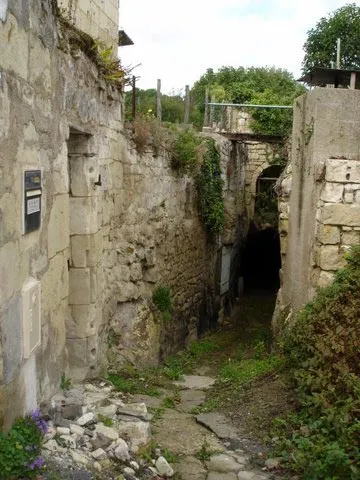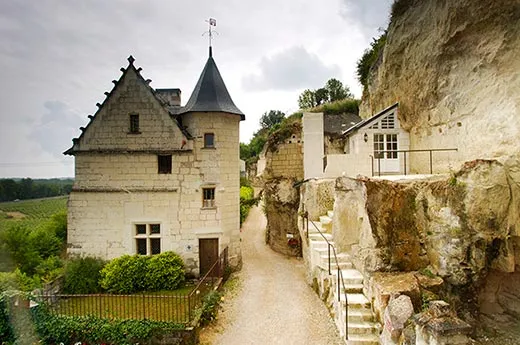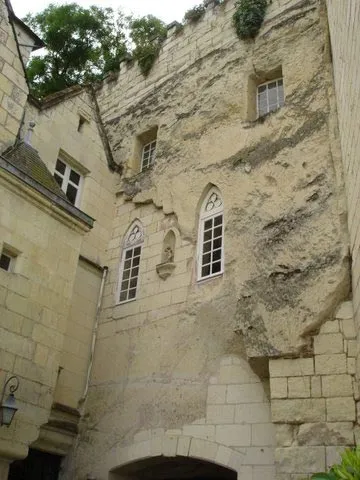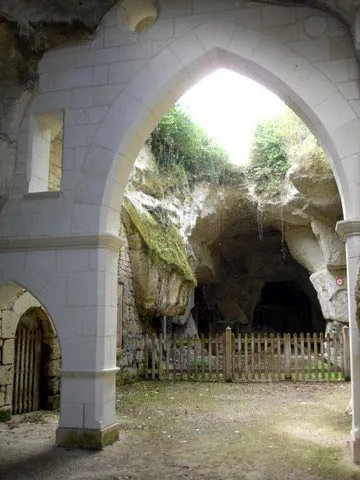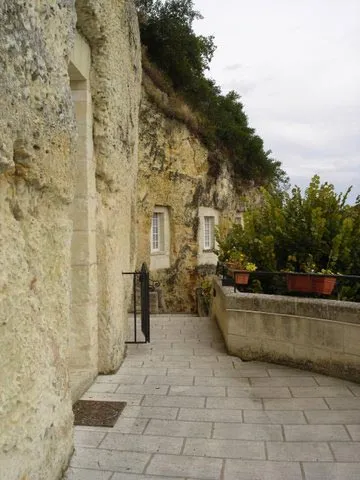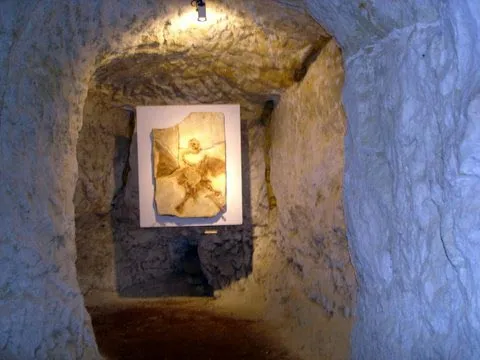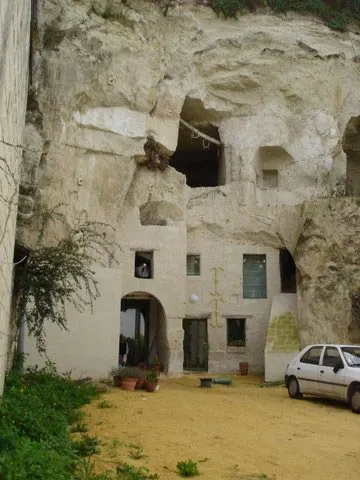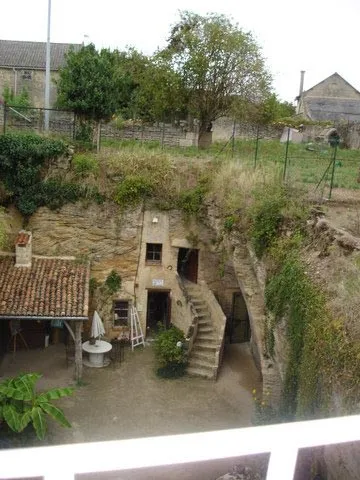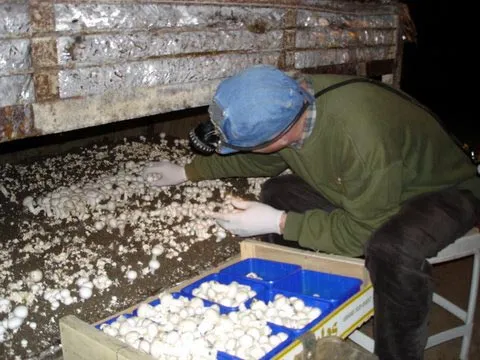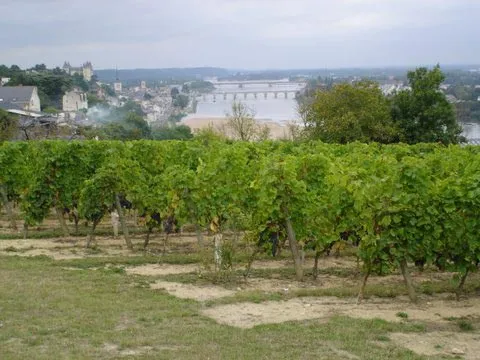A Tour of France’s Cave Homes
In France’s Loire Valley, domesticated cave dwellings, known as troglodyte homes, offer a history as rich as the region’s chateaus
/https://tf-cmsv2-smithsonianmag-media.s3.amazonaws.com/filer/Demeure-de-la-Vignole-Hote-631.jpg)
I tip the torchlight and examine a wall in my hotel room. From a distance, the wall looks like vanilla frosting roughly applied. Up close, I see nuggets of caramel-colored stone, faint brown streaks…and an oyster shell. The wall before me is 100 million years old, the raw edge of a cave scraped into a cliff above the Loire River. The oyster was a much earlier guest here, a fossil left from the sea that once covered this part of France and left behind a thick bed of white stone called tuffeau.
Many buildings in the Loire Valley are constructed from this stone. On a trip to France four years ago, I stayed in an elegantly restored farmhouse near Tours, its walls made of tuffeau blocks, stacked like irregular sugar cubes. The farmers of long ago probably dug their own tuffeau. It’s just under the surface--unplanted fields gleam with tuffeau churned to pebbles by the plows. However, the serious quarrying was for the signature chateaus and other monumental architecture of the Loire Valley.
At the time, I was among friends who wanted to visit all the chateaus. The first few exhausted my taste for opulence. Then, near the chateau in Amboise, I noticed caves in the cliff, some with brightly painted front doors, windows, shutters and flower boxes. As we drove around the Loire Valley, I spied more of these domesticated caves, some with chimneys thrusting through scruffy vegetation at the tops of cliffs or new facades and courtyards. Oh yes, someone finally explained: after widespread quarrying of the tuffeau began in the 11th century and created cavities in the hills and plains, people moved in. Some to escape warfare, others because the caves made convenient, low-rent dwellings. Until the early 20th century, many people lived in these so-called troglodyte homes. Entire villages were underground. Some people still live in the caves, I was told, and others are finding new uses for them. From that moment on, I was determined to find my way inside.
Three years later, I finally found my entrée to this version of the French underground. I returned to France at the end of last summer to let Robert and Annette Bonnell, computer programmers from Berkeley, California who now live in a cave home in Saumur, guide me through the Loire Valley’s mysterious underside.
Before reaching Saumur, I stopped in the village of Rochecorbon for a night at the luxurious Les Hautes Roches Hotel. Twelve of the hotel’s guest rooms are in a honeycomb of cliff caves where monks from the nearby Marmoutier Abbey hid during the 16th century Wars of Religion. No one at the hotel could tell me much more about the monks, but it was difficult to imagine an atmosphere of terror there. Softly illuminated by the light from a glass-paned door, my room was womblike, the silence of the tuffeau mysterious and absolute. I knew the monks hid in deeper tunnels, that my room likely occupied only the mouth of one of their caves. In wakeful moments, I imagined their ghosts stirring deep inside the stone.
In the morning, I headed toward Saumur on old highway N 952, along the Loire. An hour or so later, I arrived in Saumur—not just where Bonnells live, but the epicenter of troglo life in France. There are hundreds of miles of caves in and around Saumur, some bored into the hillsides, some under the plains. Most are abandoned. Others have been revamped as troglo hotels, restaurants, museums, artist galleries, wineries, farms for mushrooms, silkworms and snails, a rose water distillery and a disco. Even a troglo zoo, where large animals live in open quarries and enclosed caves display bats and other lovers of dim light.
The Bonnells live in a neighborhood of caves on a cliff along the south bank of the Loire—Saumur nestles into this cliff, as do a number of villages. As with many troglo homes, the façade of their house has been extended with neat blocks of tuffeau while the back curves into the cliff—a storage room opened into dark, abandoned cave until they sealed the gap. Their patio and garden are just over the third floor, atop the cliff, overlooking the Loire and Saumur’s castle. Inside, shelves and cubicles and even a nook for a bathtub are carved into the stone; doorways are braced with hand-carved beams. The Bonnells hang many mirrors to spread the light from the windowed side of the house. The effect is magical.
“Everyone in the area is always covered with tuffeau,” Annette laughs, as she brushes some of the white dust from her living-room wall off my jacket.
We begin with a driving/walking tour of some of the cliffside villages thick with troglo sites, although one could do this entirely by foot. The Grande Randonnée 3 (GR3), one of France’s great walking trails, runs behind the castle in downtown Saumur up into the vineyards at the top of the cliff, then dips up and down through the villages below. Horses and workmen used to bring the grape harvest from the fields along these trails— narrow, but not too narrow for intrepid villagers with cars.
We park near the mayor’s office in Souzay as we follow the “troglo” sign to the Chemin des Ecoliers—the “street of the schoolchildren”—and climb toward the dozens of houses that angle out of the cliff. Most have smooth mortared-stone facades, with formal entryways and busy courtyards—a startling contrast to the parts that are still rugged cliff, vines hanging over upper-story windows like untended hair. Souzay’s claim to fame is a turreted 15th century troglo chateau. A plaque claims that Marguerite d’Anjou—the English queen during the War of the Roses—spent her final years here. “The unhappiest of queens, wives, and mothers!” Robert translates. Both Souzay and Turquant, a few miles to the east, are working hard to reclaim their many abandoned caves—there are dozens of boarded-up holes, as well as paths through gashes in the cliff that lead to empty courtyards and overgrown caves. We wander every one of these hushed paths. But back on the village streets, there are signs of improvement: rods drilled into the cliff to stabilize the cavities, new facades over old caves. Turquant has developed a row of caves overlooking the Loire into a cluster of ateliers, where artisans work, teach classes and display their work. Today, only one is open: Marc Boutfol, a gilder who repairs and replicates old frames, shrines, and family crests using traditional, natural materials. He opens a jar of gold powder and thrusts it forward for our inspection. “It’s harmless!” he declares. His wife dips in a finger and dusts her eyelids gold to prove the point.
We head for the flatlands west of Saumur the next day, where miles of caves lie under planted fields and tidy stone villages. Here, some of the quarrying began with an opening on the surface that fanned out, creating vast cathedral-ceiling rooms below. Other quarries cleared a space on the plain, then opened long, labyrinthine tunnels along the sides where entire villages lived. The stone is younger here, not tuffeau but faluns—darker, coarser and a mere ten million years old.
In Doué-la-Fontaine, we visit La Rose Bleue pottery studio, heading down stone stairs into a courtyard while goats peer from the field above. Fifty years ago, parts of the studio’s cathedral-ceiling caverns were inhabited; now the potter plans to move herself and her two children into the space. We visit La Cave Vivante, a sprawling underground mushroom farm where the champignonniste plays New Age music for his fungi and offers an Omnimax-type show in one of the cave’s rounded chambers. We eat at Les Caves de la Genevraie in Rochemenier, a troglo restaurant where the waitress recommends that we amble between courses through what was once the underground home for a community of farmers.
Finally, we turn back to tuffeau and arrive at Le Manoir de la Caillère, the gallery of artist Richard Rak. I’ve seen many uses for the troglo caves over the last few days, but Rak’s work—painting combined with found objects to create images of mysterious portent—complement them best. As he takes us through a maze of white tunnels opening into the grottoes that display each piece, he tries to explain what drew him to this place.
“I’m nourished by the silence and introspection of the cave,” he says. “It is as if ancient things are lying dormant.”Yes to all that.
Author’s Note – Troglo Travel
From Paris, take the TGV train from the airport to the St. Pierre des Corps station at Tours, where you can rent a car. Les Hautes Roches in Rochecorbon is just a few miles east of Tours—stay for dinner, if you can, as I had possibly the best meal of my life there. Just outside Saumur, I stayed at the charming, comfortable and very reasonably priced Ami Chenin, a troglo bed and breakfast in an 18th century winemaker’s house. Hosts France and Xavier Amat are also winemakers.
For information about and direction to troglo sites in the Saumur area, contact their tourism office: Carrefour Anjou Touraine Poitou (CATP), an association that preserves and promotes the region’s subterranean heritage: http://www.catp-asso.org/web
On June 13-14, CATP will host Rendezvous in the Caves, a weekend in which cave homes and enterprises usually closed to the public will welcome visitors.
Planning Your Next Trip?
Explore great travel deals
Smithsonian magazine participates in affiliate link advertising programs. If you purchase an item through these links, we receive a commission.
